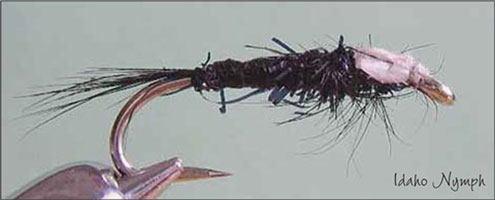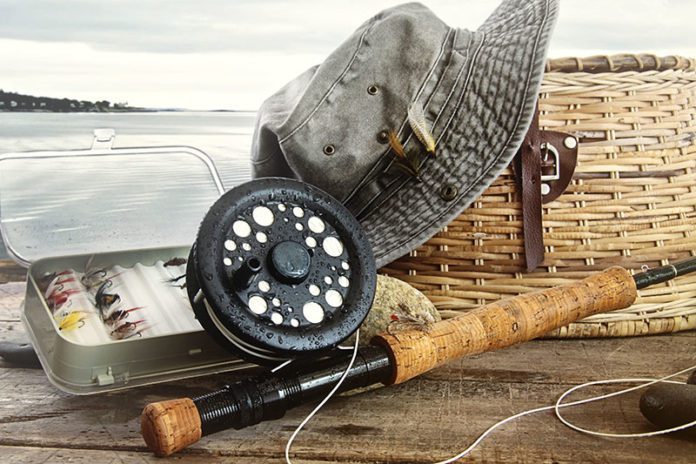Idaho Nymph and 52 Buick
Every year I plan the flies for Fly of the Month for the year. One of the things I hear when I am on the water is what are you using. This year I will share with you my flies that I use, and how to fish them. These two flies are two of my favourite flies. Enjoy…
A fly fisher friend re-introduced me to the Idaho nymph fly when he achieved great success fishing Watch Lake, just above Green Lake in the Central Cariboo. I had forgotten how productive this fly was for me. The surprising fact was that it was mid-summer, a time when trout fishing is usually deemed to be in the doldrums and golf is the better activity! We were both camped at Watch Lake and observed that fish were surface rolling as evening approached. He recounted that he tried several flies but only hit on success when he used an Idaho Nymph, fished just under the surface. This fly was exactly the ticket for that summer day.

The count and retrieve presentation is the way to fish these flies on any lake. The rate of decent will be based on the type of sinking line you decide to use. After you cast, count the seconds of decent that you need to get to the bottom or a certain depth. It’s important to have some knowledge of the depth of the water and bottom structure. In shallow lakes, there is mostly submerged weed beds, and you might want to use an intermediate sinking line or a floating line with a long leader, and count only to a depth that your nymph will not get hung up in the weeds as fish are often found close to the bottom.
Since nymphs are inherently slow moving creatures, the speed of retrieve is crucial and should generally be very slow. For most nymph patterns, especially the imitative ones, the usual retrieve speed is somewhere between static and an extremely slow figure of eight. Nymphs are small creatures and don’t swim quickly, so your retrieve needs to mimic this.
Some nymphs barely move at all, so just letting your nymphs move around in the current while maintaining contact by removing slack with a figure of eight retrieve is the best route to success.
The fishing method that worked for us was to fish in shallow water, using figure of eights, turns with a slow pull retrieve with several short two- to four-inch pulls every 15 to 20 seconds, and when we were fishing deeper water on sinking lines, we let the fly sink near the bottom before we started to retrieve. When we did some trolling we used a full or intermediate sinking line, doing “S” curves, moving from the shallow water to the deeper water. Fishing the drop offs.
Idaho Nymph
Thread: Invisible mending
Body: Black Chenille, Phentex or Wool
Ribbing: Black Ostrich Herl
Hackle: Black Saddle
Thorax: Peacock Herl
Wing Case: White Goose Quill
Tail: Black Saddle Hackle
Tying Instructions
- Pinch your barb down on the hook.
- Lay down a thread base on the shank of the hook.
- Tie in black saddle fibers for a tail no longer than one third of the hook length.
- Tie in black chenille, wool or Phentex near bend, also a black ostrich herl at the hook shank. First wind your body material towards the hook eye, then counter wrap the ostrich herl as an evenly spaced rib to the hook eye. Leave space of ¼ inch before eye and secure.
- Tie in White Goose quill for wing case.
- Tie in a black saddle hackle for beard.
- Tie in about five strands of peacock herl for the thorax. Tying peacock herl in by the tips to ensure a full thorax. Winding the peacock herl forward to create the thorax.
- Wrap the saddle hackle around thorax to create legs.
- Pull the white goose quill over the thorax to create the wing case and tie off.
- Head cement.
52 Buick
With varying hook sizes and different shades of body green, the fly can represent many aquatic insects such as dragon flies and shrimps or more accurately called scuds.
When I lived in Alberta I used this fly successfully in foothill rivers such as the Caroline and Raven. I then started using it in lakes and became an almost instantaneous hit. It can be trolled or cast with equally great effectiveness but best results tend to be in the June period. I have found that if the green body color of this fly matches the lake bottom vegetation shades, I can count on some action even on those slow fish days. On some lakes, a very bright green often works best.

Thread: Invisible mending
Head: Peacock herl
Body: Green wool, Chenille or various dubbing materials (seal)
Ribbing: Gold Tinsel
Hackle: Guinea hen
Tail: Guinea Hen
Tying Instructions
- Tie in tail allowing it to project about 1/4 inch past the hook bend.
- Secure a three- to four-inch piece of thin gold tinsel at the hook bend.
- Tie in the body material. I often mix green and blue seal hair to make a body dubbing and I use several shades of green.
- Wind body material to the hook eye.
- Next, counter wrap the gold tinsel in a manner that produces bumps in the body material between the tinsel wraps.
- Add guinea throat hackle and then complete the fly with a generous wrap of peacock herl to form a fairly large head.
- Whip finish and cement.






